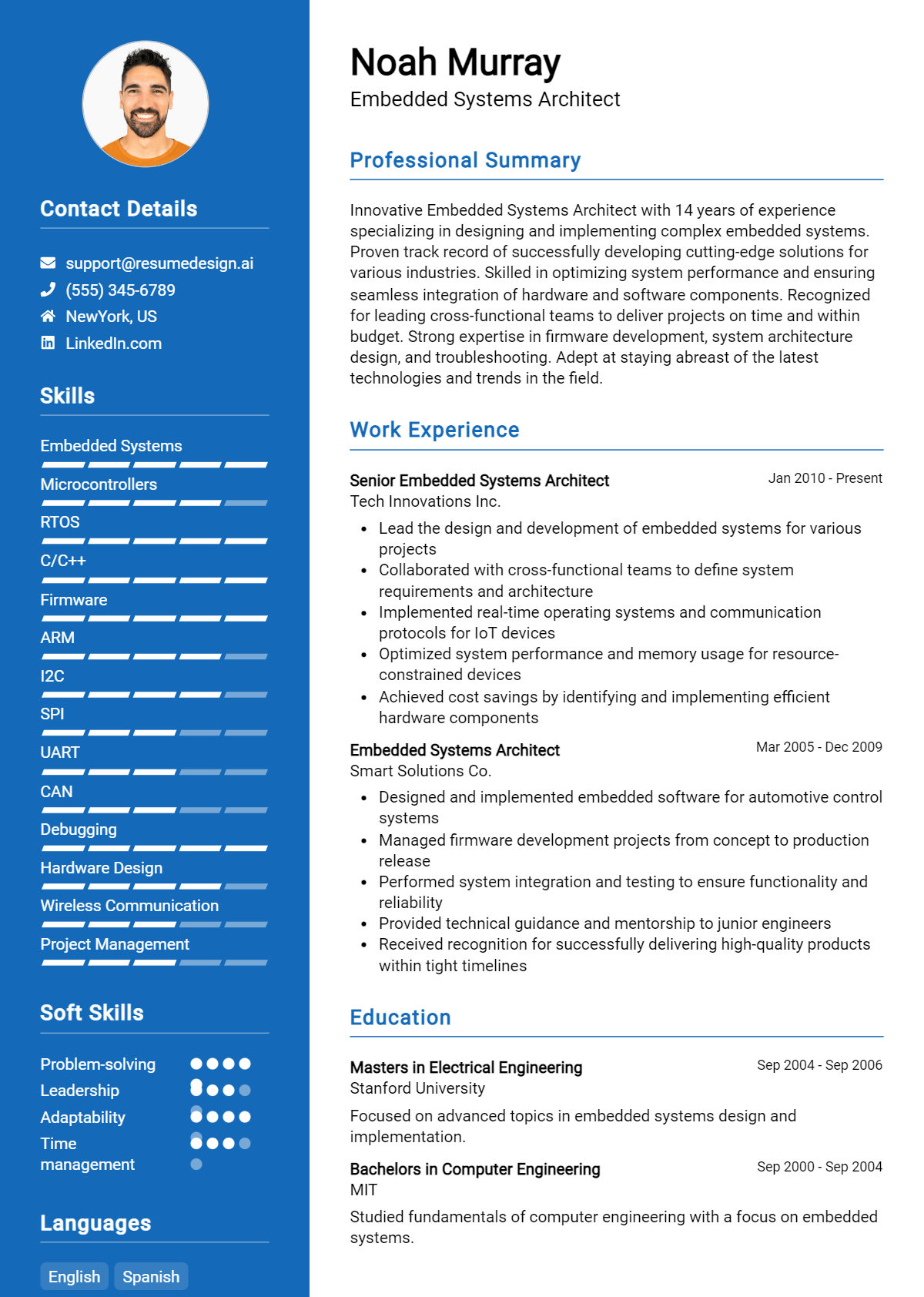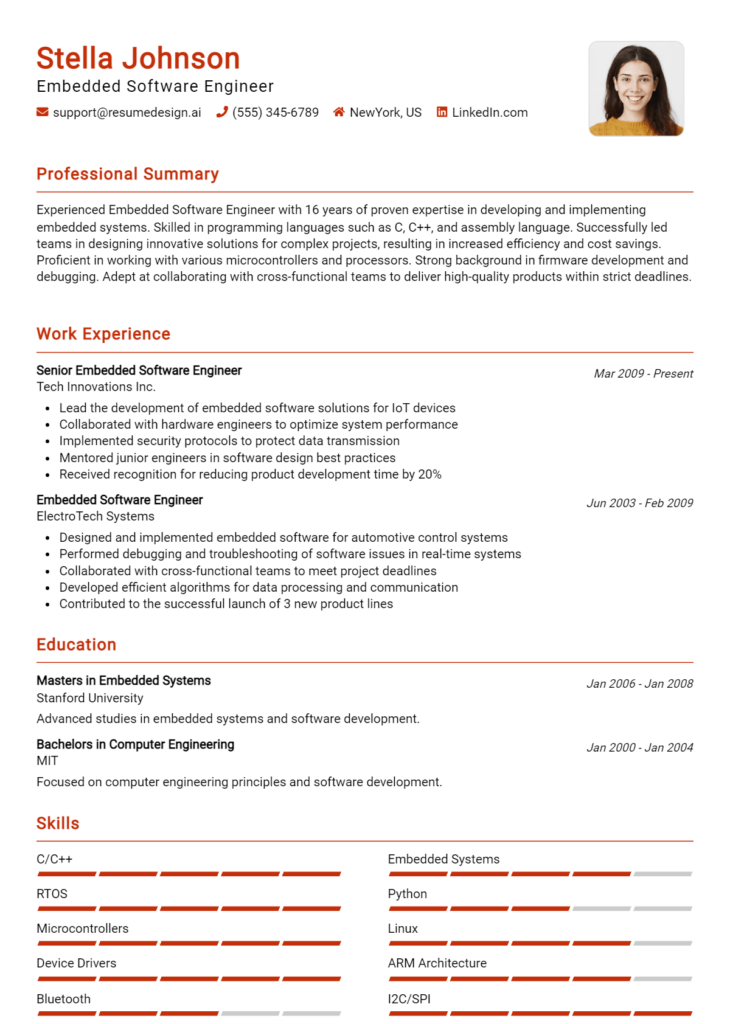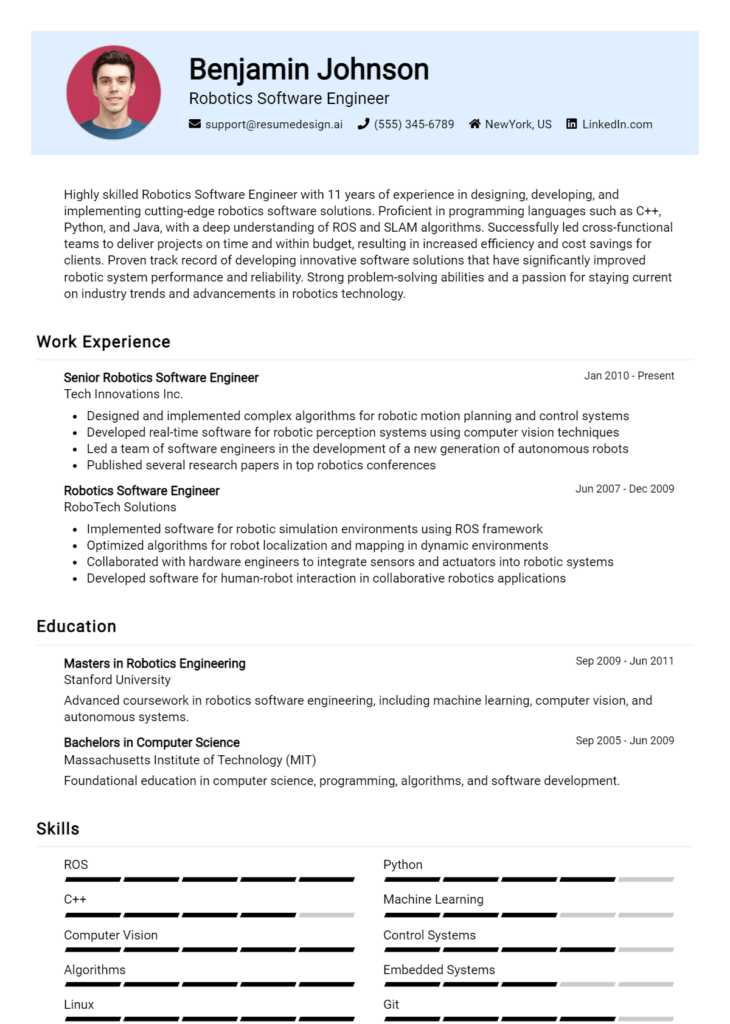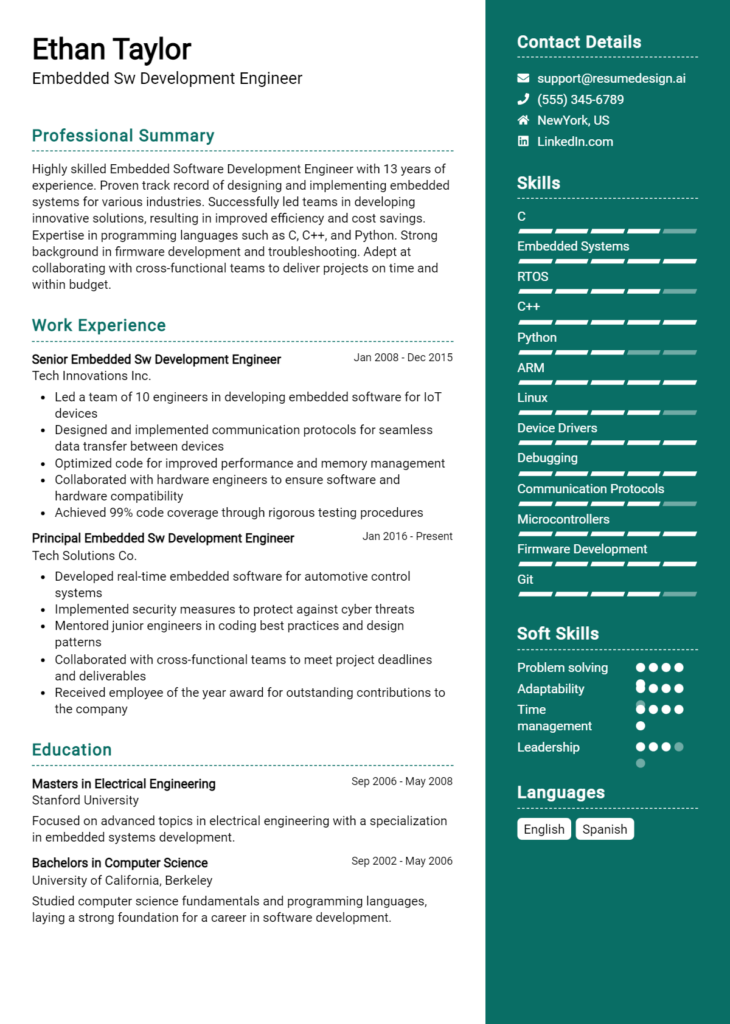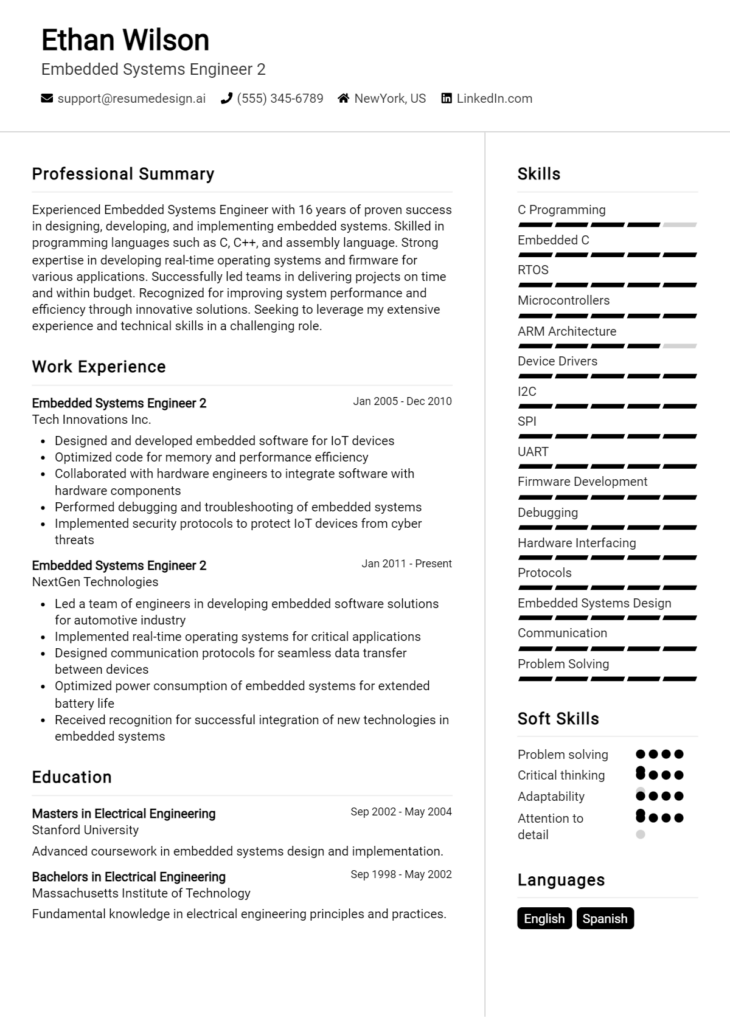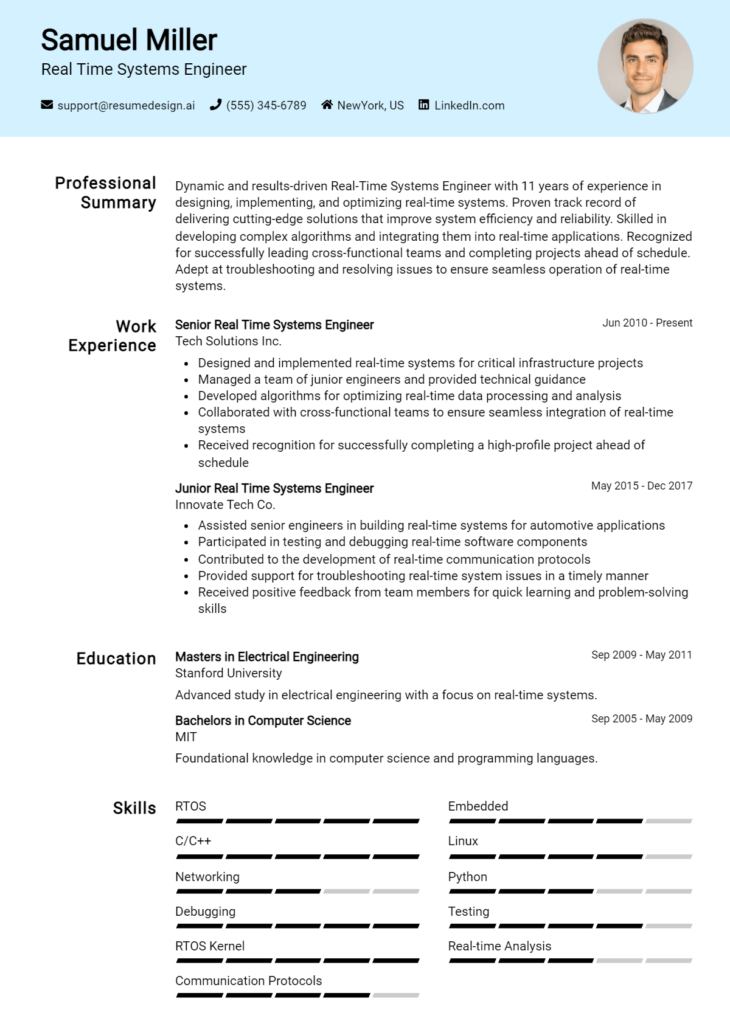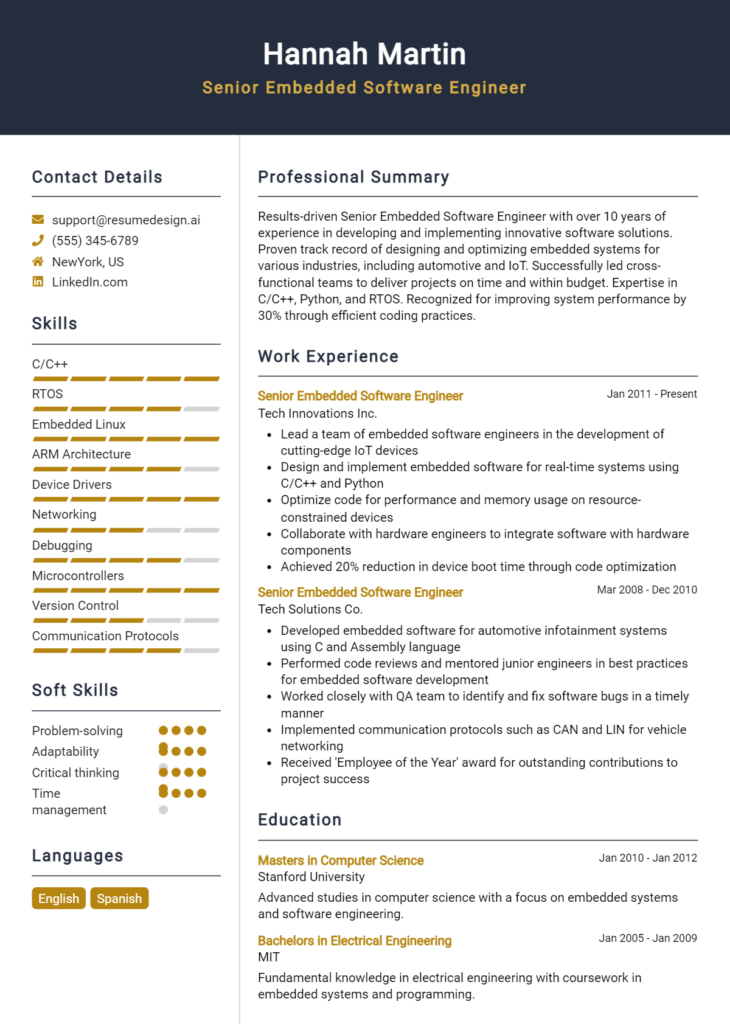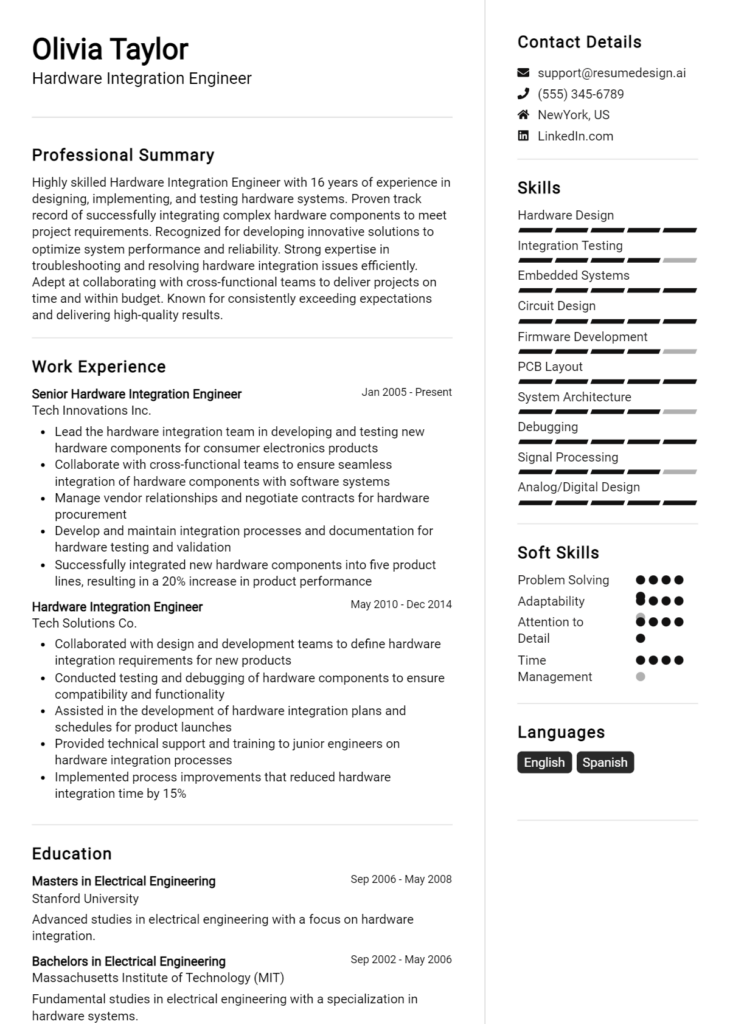Embedded Systems Architect Core Responsibilities
An Embedded Systems Architect plays a pivotal role in designing and integrating embedded systems across various departments, ensuring seamless communication between hardware and software teams. Essential skills include technical expertise in microcontrollers, strong operational acumen, and adept problem-solving abilities. These competencies are vital for aligning project goals with organizational objectives, enhancing efficiency and innovation. A well-structured resume can effectively highlight these qualifications, showcasing the candidate's potential to drive success within the organization.
Common Responsibilities Listed on Embedded Systems Architect Resume
- Design and develop embedded systems architecture for various applications.
- Collaborate with cross-functional teams including hardware, software, and QA.
- Conduct feasibility studies and risk assessments for new projects.
- Define system specifications and requirements based on stakeholder needs.
- Oversee the integration of hardware and software components.
- Perform performance analysis and optimization of embedded systems.
- Ensure compliance with industry standards and regulations.
- Provide technical guidance and mentorship to engineering teams.
- Debug and troubleshoot complex embedded systems issues.
- Document system architecture and design processes comprehensively.
- Stay updated with emerging technologies and industry trends.
High-Level Resume Tips for Embedded Systems Architect Professionals
In the competitive field of embedded systems architecture, a well-crafted resume is crucial for standing out among a sea of candidates. Your resume serves as the first impression you make on potential employers, and it must effectively showcase not only your technical skills but also your achievements and contributions to past projects. A strong resume can open doors to interviews and opportunities that align with your career ambitions. This guide will provide practical and actionable resume tips specifically tailored for Embedded Systems Architect professionals, helping you to create a compelling narrative that resonates with hiring managers.
Top Resume Tips for Embedded Systems Architect Professionals
- Tailor your resume to each job description by incorporating keywords and phrases from the posting, demonstrating that you meet the specific qualifications sought by the employer.
- Highlight relevant experience in embedded systems design and development, showcasing your roles in specific projects and the technologies used.
- Quantify your achievements where possible, using metrics to illustrate the impact of your work, such as performance improvements or cost savings.
- Emphasize industry-specific skills, such as proficiency in languages like C/C++, knowledge of real-time operating systems, and familiarity with hardware-software integration.
- Include certifications or training relevant to embedded systems, such as those from IEEE or other professional organizations, to enhance credibility.
- Utilize a clean and professional format that improves readability, ensuring that key information stands out to hiring managers.
- Incorporate a summary statement that encapsulates your experience and value proposition, making a strong opening statement to engage the reader.
- List relevant technical projects in a dedicated section, detailing your contributions, technologies used, and the outcomes achieved.
- Showcase soft skills that are critical for collaboration and communication within teams, especially given the multidisciplinary nature of embedded systems projects.
- Keep the resume concise, ideally within one to two pages, focusing on the most relevant information to maintain the reader's attention.
By implementing these tips into your resume, you can significantly enhance your chances of landing a job in the Embedded Systems Architect field. A polished and targeted resume not only highlights your qualifications but also tells your professional story in a way that captures the interest of hiring managers, making you a strong contender for the roles you seek.
Why Resume Headlines & Titles are Important for Embedded Systems Architect
In the competitive field of embedded systems architecture, a well-crafted resume headline or title serves as a pivotal first impression for potential employers. It is the first element a hiring manager sees, and its purpose is to capture attention and succinctly convey the candidate's core qualifications and unique selling points. An effective headline encapsulates key skills, experiences, or accomplishments in a concise manner, directly aligning with the specific job being applied for. This not only helps in standing out amidst a sea of applicants but also sets the tone for the rest of the resume, guiding the reader's expectations about the candidate's expertise and suitability for the role.
Best Practices for Crafting Resume Headlines for Embedded Systems Architect
- Keep it concise—aim for one impactful phrase.
- Make it role-specific to clearly indicate your area of expertise.
- Incorporate relevant keywords from the job description.
- Highlight your most significant skills or accomplishments.
- Avoid jargon or overly technical language that may confuse.
- Use action-oriented language to convey proactivity.
- Tailor your headline for each application to match the role.
- Ensure it reflects your unique value proposition as a candidate.
Example Resume Headlines for Embedded Systems Architect
Strong Resume Headlines
Innovative Embedded Systems Architect with 10+ Years in Automotive Solutions
Results-Driven Architect Specializing in IoT Device Development and Optimization
Lead Embedded Systems Engineer with Proven Track Record in Firmware Development
Strategic Embedded Architect Focused on High-Performance, Low-Power Designs
Weak Resume Headlines
Experienced Engineer Seeking New Opportunities
Embedded Systems Professional
The strong headlines are effective because they are specific, showcasing relevant skills and experiences that align with the job description, thus immediately appealing to hiring managers. They provide clear insight into the candidate's qualifications, making it easy for recruiters to see the value the candidate brings. Conversely, the weak headlines fail to impress due to their vagueness; they lack specificity and do not communicate any unique skills or accomplishments, which makes it difficult for hiring managers to gauge the candidate's fit for the role at a glance.
Writing an Exceptional Embedded Systems Architect Resume Summary
Crafting a compelling resume summary is crucial for an Embedded Systems Architect as it serves as the first impression to potential employers. A strong resume summary quickly captures the attention of hiring managers by succinctly showcasing key skills, relevant experience, and notable accomplishments tailored to the specific job role. It should provide a clear, impactful snapshot of the candidate’s qualifications, setting the stage for the rest of the resume and enhancing the chances of being selected for an interview.
Best Practices for Writing a Embedded Systems Architect Resume Summary
- Quantify Achievements: Use specific numbers to demonstrate your impact, such as percentage improvements or budget sizes.
- Focus on Relevant Skills: Highlight key skills that are specifically mentioned in the job description.
- Tailor the Summary: Customize your summary for each job application to reflect the requirements and expectations of the role.
- Keep it Concise: Limit your summary to 3-5 sentences to ensure clarity and brevity.
- Use Industry Terminology: Incorporate relevant technical jargon and keywords that resonate with hiring managers.
- Showcase Soft Skills: Include interpersonal skills that are important for collaboration and communication within teams.
- Highlight Problem-Solving Abilities: Emphasize your capacity to address challenges and deliver innovative solutions.
- Maintain a Professional Tone: Keep the language formal yet engaging to appeal to a professional audience.
Example Embedded Systems Architect Resume Summaries
Strong Resume Summaries
Dynamic Embedded Systems Architect with over 10 years of experience in developing real-time systems for automotive applications, resulting in a 30% increase in efficiency. Proven track record in leading cross-functional teams and managing projects with budgets exceeding $5 million.
Results-driven Embedded Systems Architect skilled in designing embedded software solutions, achieving a 25% reduction in time-to-market for key product launches. Proficient in C/C++, ARM architecture, and Agile methodologies.
Innovative Embedded Systems Architect with expertise in IoT device integration, successfully launching over 15 products that enhanced user experience and increased customer engagement by 40%. Strong leader with excellent communication skills.
Weak Resume Summaries
Experienced embedded systems professional looking for new opportunities in a challenging environment.
Embedded Systems Architect with skills in programming and project management, seeking to contribute to a team.
The examples of strong resume summaries are considered effective because they provide specific details about the candidate’s achievements, quantify results, and highlight relevant skills tailored to the role of an Embedded Systems Architect. In contrast, the weak resume summaries lack detail and specificity, making them vague and unmemorable, ultimately failing to capture the interest of hiring managers.
Work Experience Section for Embedded Systems Architect Resume
The work experience section is a pivotal component of an Embedded Systems Architect resume, as it serves as a testament to the candidate’s technical skills, leadership capabilities, and dedication to delivering high-quality products. This section not only outlines previous roles and responsibilities but also highlights the candidate's ability to manage teams effectively and collaborate with cross-functional stakeholders. By quantifying achievements and aligning experiences with industry standards, candidates can provide compelling evidence of their qualifications and readiness to tackle complex embedded systems challenges.
Best Practices for Embedded Systems Architect Work Experience
- Focus on specific technical skills relevant to embedded systems, such as programming languages, hardware design, and development tools.
- Use quantifiable metrics to demonstrate the impact of your work, such as improved efficiency, reduced costs, or increased performance.
- Highlight leadership roles and team management experience, showcasing how you guided projects to successful completion.
- Include keywords and industry standards that align your experience with the expectations of potential employers.
- Emphasize collaboration and communication with cross-functional teams, underlining the importance of teamwork in embedded systems development.
- Tailor your work experience to reflect the specific requirements of the job you are applying for, making it relevant and targeted.
- Showcase your problem-solving abilities by detailing challenges faced and innovative solutions implemented.
- Keep descriptions concise and impactful, ensuring clarity and easy readability for hiring managers.
Example Work Experiences for Embedded Systems Architect
Strong Experiences
- Led a team of 10 engineers in the development of a real-time embedded control system, achieving a 30% reduction in response time while maintaining system reliability.
- Implemented a new software architecture that enhanced system scalability, resulting in a 50% increase in project delivery speed and a 20% decrease in development costs.
- Collaborated with cross-functional teams to design a low-power embedded device that won the 2022 Innovation Award, significantly boosting product marketability.
- Conducted comprehensive testing and validation processes that improved product performance metrics by 40%, ensuring compliance with industry standards.
Weak Experiences
- Worked on various embedded systems projects without specifying the technical contributions or outcomes.
- Assisted in team meetings and discussions regarding project development without detailing specific roles or responsibilities.
- Involved in the design of embedded systems but did not quantify the impact or improvements made.
- Participated in testing activities without mentioning the results or any enhancements achieved through those efforts.
The examples provided highlight the contrast between strong and weak experiences. Strong experiences are characterized by specific, quantifiable outcomes that demonstrate technical leadership and successful collaboration. In contrast, weak experiences tend to lack detail, fail to quantify results, and do not effectively convey the candidate's contributions, making them less compelling to potential employers.
Education and Certifications Section for Embedded Systems Architect Resume
The education and certifications section of an Embedded Systems Architect resume is a critical component that showcases a candidate's academic foundation, relevant certifications, and commitment to ongoing professional development. This section not only highlights the educational achievements that are pertinent to the field but also emphasizes industry-recognized certifications that validate the candidate's expertise. By providing details about relevant coursework and specialized training, candidates can significantly enhance their credibility and demonstrate their alignment with the specific requirements of the job role, making them more attractive to potential employers.
Best Practices for Embedded Systems Architect Education and Certifications
- Prioritize relevant degrees, such as Electrical Engineering, Computer Engineering, or Computer Science.
- Include industry-recognized certifications like Certified Embedded Systems Engineer (CESE) or Certified Software Development Professional (CSDP).
- List relevant coursework that demonstrates expertise in embedded systems, real-time operating systems, and hardware-software integration.
- Highlight any specialized training programs or workshops that focus on recent technologies and tools in embedded systems.
- Use clear and concise formatting to make the information easily readable for hiring managers.
- Keep the section updated with the latest certifications and educational achievements to reflect continuous learning.
- Consider including GPA or honors if they are notably high or relevant to the field.
- Avoid overly general or outdated qualifications that do not directly apply to embedded systems architecture.
Example Education and Certifications for Embedded Systems Architect
Strong Examples
- Bachelor of Science in Electrical Engineering, University of California, 2018
- Certified Embedded Systems Engineer (CESE), 2021
- Relevant Coursework: Advanced Embedded Systems Design, Real-Time Operating Systems, Microcontroller Programming
- Professional Development: Completed a workshop on IoT Protocols and Standards, 2022
Weak Examples
- Bachelor of Arts in History, University of Texas, 2015
- Certified Personal Trainer, 2019
- Relevant Coursework: Introduction to Business, 2016
- Certification in Basic First Aid, 2020
The strong examples are considered effective because they directly relate to the skills and knowledge necessary for an Embedded Systems Architect role, showcasing relevant degrees, certifications, and specialized training that align with industry needs. In contrast, the weak examples lack relevance to the field of embedded systems; degrees and certifications that do not pertain to technology or engineering do not contribute to the candidate's qualifications for the position, potentially diminishing their appeal to employers in this specialized area.
Top Skills & Keywords for Embedded Systems Architect Resume
An Embedded Systems Architect plays a crucial role in the development and integration of complex systems that combine hardware and software components. Crafting a standout resume for this position requires a keen focus on relevant skills, as they demonstrate not only technical proficiency but also the ability to manage projects and collaborate efficiently with cross-functional teams. Highlighting both hard and soft skills is essential, as employers seek candidates who can navigate the intricacies of embedded systems while maintaining effective communication and problem-solving capabilities. By showcasing a blend of these skills, applicants can better position themselves as strong contenders for the role.
Top Hard & Soft Skills for Embedded Systems Architect
Soft Skills
- Problem-solving
- Critical thinking
- Communication
- Team collaboration
- Adaptability
- Time management
- Attention to detail
- Creativity
- Leadership
- Conflict resolution
Hard Skills
- Embedded C/C++ programming
- Microcontroller architecture
- Real-time operating systems (RTOS)
- Hardware design and development
- FPGA programming
- Signal processing
- Debugging and testing
- System design and analysis
- Knowledge of communication protocols (e.g., I2C, SPI, UART)
- Software development lifecycle (SDLC)
To enhance your resume further, consider integrating your skills with a robust work experience section to illustrate how you've applied these competencies in real-world scenarios.
Stand Out with a Winning Embedded Systems Architect Cover Letter
Dear Hiring Manager,
I am writing to express my interest in the Embedded Systems Architect position at [Company Name], as advertised on [Job Board/Company Website]. With over [X years] of experience in designing and developing sophisticated embedded systems, I am excited about the opportunity to contribute my expertise in creating innovative solutions that meet both technical and business requirements. My background in systems architecture, combined with a strong foundation in software development and hardware integration, uniquely positions me to excel in this role.
Throughout my career, I have successfully led cross-functional teams in the design and implementation of embedded systems for various applications, including automotive, consumer electronics, and industrial automation. My proficiency in programming languages such as C, C++, and Python, along with my experience in using tools like MATLAB and Simulink, has enabled me to create robust and efficient system architectures. I am particularly proud of a project where I spearheaded the development of a real-time embedded system that improved performance by 30% while reducing costs by 15%. This experience has honed my ability to balance technical excellence with strategic thinking, ensuring that projects align with organizational goals.
I am particularly drawn to [Company Name] because of its commitment to innovation and quality in the embedded systems domain. I am eager to bring my skills in requirements analysis, system design, and risk management to your team. I am confident that my collaborative approach, along with my passion for pushing the boundaries of technology, will contribute to the ongoing success of your projects. I look forward to the opportunity to discuss how my background and vision align with the objectives of your esteemed company.
Thank you for considering my application. I hope to speak with you soon about how I can contribute to [Company Name] as an Embedded Systems Architect.
Sincerely,
[Your Name]
[Your Phone Number]
[Your Email Address]
Common Mistakes to Avoid in a Embedded Systems Architect Resume
When crafting a resume for the role of an Embedded Systems Architect, it’s crucial to present your skills and experience in a clear and compelling manner. However, many candidates make common mistakes that can undermine their chances of landing an interview. These pitfalls often stem from a lack of understanding of what hiring managers are looking for in this specialized field. Below are some common mistakes to avoid when creating your resume:
Vague Job Descriptions: Failing to provide specific details about your roles can make your experience seem irrelevant. Use clear, quantifiable achievements to highlight your contributions.
Overly Technical Jargon: While technical terms are important, using too much jargon can alienate hiring managers who may not be familiar with every acronym. Aim for clarity without sacrificing technical depth.
Ignoring Soft Skills: Focusing solely on technical abilities can overlook the importance of soft skills like communication, teamwork, and problem-solving, which are vital for an architect role.
Lack of Tailoring: Sending out a generic resume does not showcase your fit for a specific job. Tailor your resume for each position by aligning your skills and experience with the job description.
Omitting Relevant Certifications: Not including industry-recognized certifications can be a missed opportunity to demonstrate your qualifications. Ensure you highlight any relevant certifications, especially in embedded systems.
Poor Formatting and Structure: A cluttered or confusing resume can detract from your qualifications. Use a clean layout with clear headings and bullet points to enhance readability.
Neglecting Continuous Learning: Failing to mention ongoing education or training can suggest stagnation. Highlight any recent courses, workshops, or conferences attended to show your commitment to staying current in the field.
Too Much Focus on Responsibilities: Listing duties instead of achievements can make your experience seem passive. Focus on what you accomplished in each role, emphasizing outcomes and impact.
Conclusion
As we wrap up our exploration of the Embedded Systems Architect role, it's clear that this position demands a blend of technical expertise, innovative thinking, and strong problem-solving skills. An Embedded Systems Architect is pivotal in designing and developing sophisticated embedded systems that drive modern technology, from consumer electronics to automotive applications. The key takeaways highlight the importance of proficiency in programming languages, a solid understanding of hardware-software integration, and the ability to work collaboratively within multidisciplinary teams.
Given the competitive landscape in this field, having a standout resume is crucial. We encourage you to take a moment to review and refine your Embedded Systems Architect resume. Ensure it effectively showcases your skills, experiences, and accomplishments in a way that resonates with potential employers.
To assist you in this process, consider utilizing resources such as resume templates to provide a polished look, or the resume builder for an easy and efficient way to create your resume from scratch. You can also explore resume examples for inspiration and insights on how to structure your achievements. Additionally, don’t forget about the importance of a compelling introduction; check out our cover letter templates to complement your resume and make a strong impression.
Take action today and invest time in perfecting your resume. Your next opportunity as an Embedded Systems Architect could be just around the corner!

